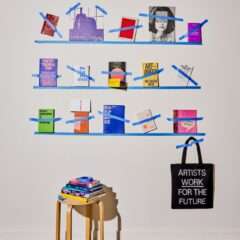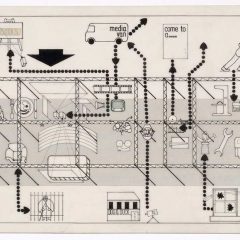This week’s Weekly (online only) has my article about Robot 250, the city-wide festival celebrating Pittsburgh’s importance as a center for robotics. Below is the copy with some pictures. More photos at flickr.

“You’re No. 1” is a robotic foam finger installed atop The Andy Warhol Museum in Pittsburgh as part of the Robot 250 Festival, July 11-27. Ian Ingram, a senior research associate and artist-in-residence at Carnegie Mellon University, built the robotic installation. When someone activates sensors in one of several remote kiosks, the robotic finger will turn and point at that person. Photo credit: Carnegie Mellon University
Behind every real world robot lies a human builder, and some of those builders — like Illah Nourbakhsh and his team at the Carnegie Mellon Robotics Institute in Pittsburgh — have been doing their best to demystify robotics in a year-long project, Robot 250, that brings robots out of lab for people to experience the fun, friendly and arty side of machines that are also incredibly useful.
Video of Green Roof roller coaster, aka Crickets and You’re Number 1! More videos at YouTube.
Robot 250 – an old fashioned art and community project with a techno-twist — is a piece of the city’s 250th birthday celebration. I went to Pittsburgh to check out the artist-made “BigBots,” eleven monumental art works commissioned for Robot 250 that use robotic parts, and heard from the students who made robots in their schools or used the Mars Rover technology, the gigapan, to document and explore their communities. Everyone was high on the project. The artists, in spite of difficulties with their electronically-controlled pieces in outdoor environments, were uniformly enthusiastic.
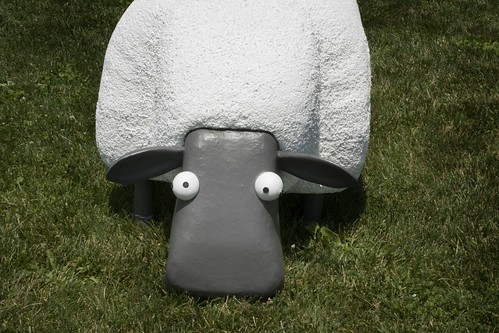
Osman Khan, Moe, big bot at the Philpps Conservatory lawn. Photo by Cate Fallon
With its strong programs in engineering and the arts, CMU has a history of entwining art with technology. And the BigBot projects – a robotic sheep that mows the lawn; a miniature roller coaster that takes plants on a ride; a chorus of noise-making robo-crickets – are the eruption of fun in this serious community education project. The art projects also show that robots don’t have to have bodies and mimic human behavior but can take many different shapes and sizes and do surprising things.
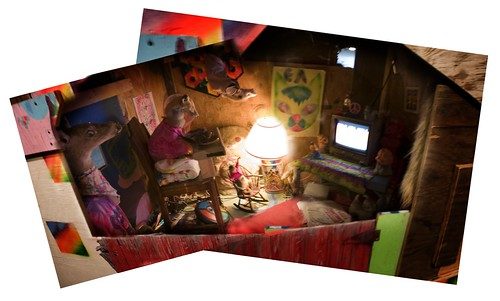
Several BigBots remain up through August although most came down last week. One of the best is still up and if you’re going over to see the Carnegie International make sure to see Extreme Animals: The Video Game by Matt Barton and Jacob Ciocci at the Carnegie Museums. The piece is a scrap wood hut containing a robo-taxidermy-wonderland with forest creatures living in pizza-fueled and video-game obsessed nirvana. Peace on.
The collaboration between Barton, a Pittsburgh artist and CMU grad, and Ciocci, one of the founders of the art collective Paper Rad, has nodding deer, a game-playing fox and an empty pizza box which opens to reveal a fat and happy squirrel. It’s a trippy “secret life of animals” reflecting today’s electronics-driven counterculture. And why wouldn’t Bambi and Thumper keep up with the times?
Barton, by the way, was in a great show of young Pittsburgh artists at Space 1026 last year. He showed some taxidermied deer! See post.
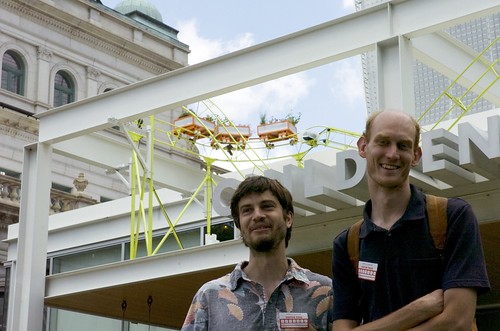
Joey Hays and Gregory Witt
Green Roof Roller Coaster,a roller coaster that takes a variety of grasses and other plants for a wild ride atop the Children’s Museum of Pittsburgh. Photo credit: Carnegie Mellon University
Another BigBot that imagines secret lives is Green Roof Roller Coaster by Gregory Witt and Joey Hays at the Children’s Museum which took a group of shaggy looking plants for a roller coaster ride and monitored their happiness quotient before and after. Our friends the plants give us a lot and maybe we owe them a little fun said the artists at the opening.
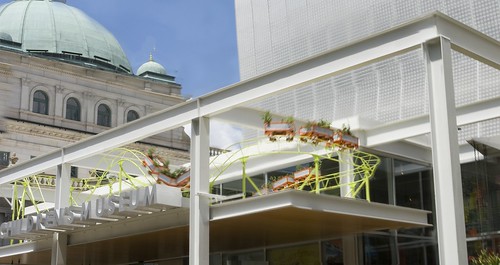
Joey Hays and Gregory Witt. Green Roof roller coaster, composite photo by Cate Fallon
I spoke with artist Ian Ingram who curated the BigBots and is co-founder of Rossum’s a working group for robotic artists and engineers. Ingram made a BigBot piece, “You’re Number 1!” on top of the Andy Warhol Museum that was no match for the wind storm that shredded it last week.
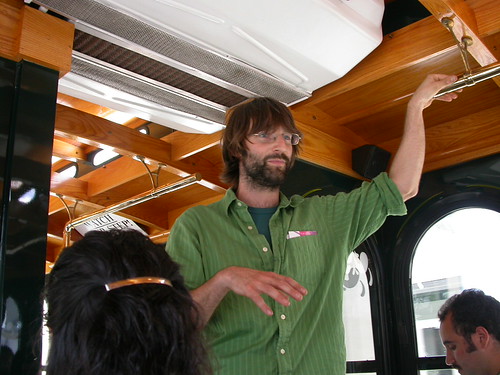
Ian Ingram explaining some aspect of the BigBots project while we were on the trolley tour of the sites around town.
The piece, a 12 ft. tall foam rubber hand with an index finger pointing (like the ones fans use at sporting events) was connected by circuitry to other spots around town and when someone activated the piece at the remote site the big hand on the museum would find the person and point back in a mutual “You’re Number 1!” love fest.
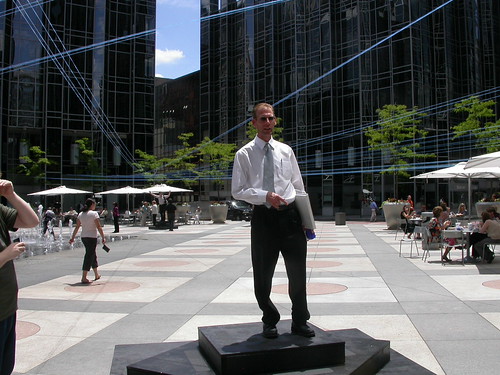
Grisha Coleman’s BigBot Reach, ROBOT is the blue cables in the space and the platforms on which people stand to reach for the cables. Audio is transmitted through the piece in response to movement in the space. This was so Matrix-y is was a little spooky. The man on the pedestal was being sketched by someone in another art activity completely unrelated to the piece or to Robot 250. Coleman is a composer.
Ingram decided against rebuilding the work and instead created a new machine—a cloud maker—that’s up there now making clouds. He calls the work “Making Peace with the Sky” and says he’s happy to go with the flow. Ingram said many of the artists are very pleased with their pieces, and for some of them it was new working with electronics and robotics. The primary goal of Robot 250 was to reach people who don’t think about technology and get them to think about how things work, says Ingram. On that level, the BigBots were a BigSuccess.
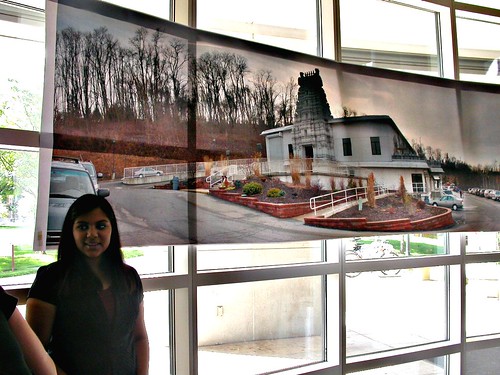
Student Priyanka Srinivasa in front of her gigapan photo of Her Hindu temple in Pittsburgh.
Robot 250 will continue this summer and into the fall with museum exhibits, make-and-take workshops and even theatre events by Squonk Opera and Quantum Theatre.
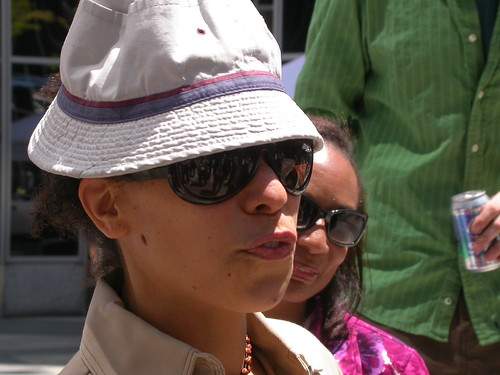
Grisha Coleman speaking about her piece, Reach Robot, at PPG Plaza.
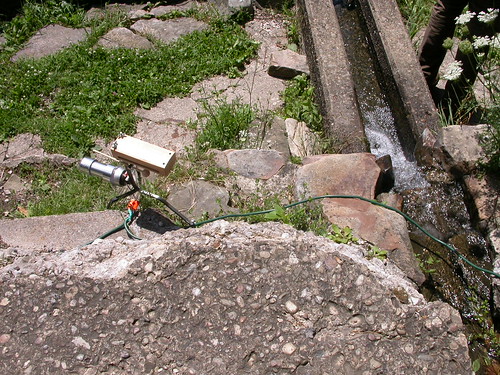
Kenny Marshall, aka Crickets at the Mattress Factory. Little wood boxes with mallets attached activated by sound. One box starts up and a box nearby “hears” and answers. Soon the whole flock is chirping. This piece was outside in Winifred Lutz’s Reclamation Garden.
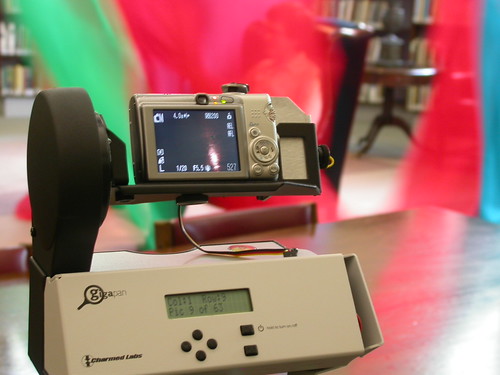
This is the gigapan technology at work taking pictures of the piece, Shelter, by Garth Zeglin, at the Carnegie Library, Main branch
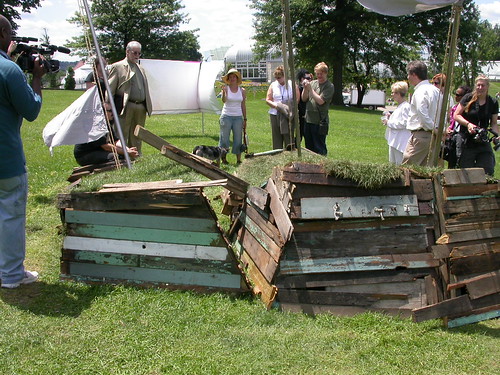
Jennifer Gooch’s piece Rise and Fall in Schenley Park. The white flags are activated by motion sensors to go up and down when people are near. This was the artist’s first public art project.
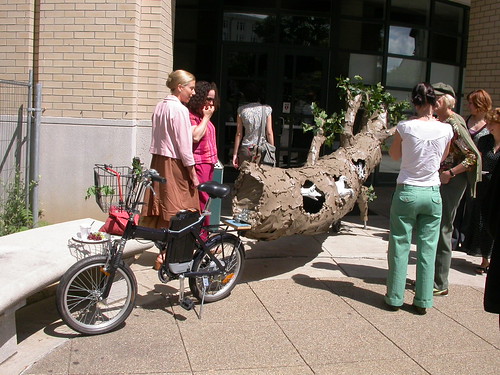
Ally Reeves Look-See Tree, part of the city’s Roving Art Cart project. Inside the faux tree were paper-constructed animals that would move slightly when you came towards them. There was a paper pigeon that laid a paper egg.
Robot 250, ongoing through Oct. 18. Pittsburgh, various locations.


